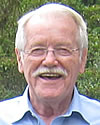 Claus F.K. Diessel |
2015 Gilbert H. Cady Award
Presented to Claus F.K. Diessel
Citation by Colin R. Ward
Claus Diessel is one of the most inspiring personalities in the field of coal geology. He has made a very distinguished contribution to research at the international level over more than 50 years, including major advances in pure and applied coal petrology and in the sedimentology of coal-bearing sequences. Indeed, there is scarcely any aspect of basic or applied coal geology that has not received attention at some stage of his illustrious career.
Among his many contributions Claus is best known for his work on interpretation of peat-forming environments based on coal petrographic characteristics combined with environmental analysis of the associated sediments. His seminal book “Coal‐bearing Depositional Systems” provides a classic exposition of the concepts involved, and his two indices of coal facies (gelification index and tissue preservation index) continue to be used (and sometimes misused) by researchers to help understand an ever-widening range coal deposits.
Another major contribution is represented by his pioneering research on the reactivity of inertinite and other macerals during coking processes. This had, and continues to have, implications world-wide for coal marketing and use.
Claus has also carried out extensive investigations into the sequence stratigraphy of coal-bearing successions, providing a basis for understanding coal distribution and quality both spatially and through geologic time. Although much of his research has been based on Australian and European coals, many of his sequence stratigraphy studies have focused on North American successions. The results of all his work nevertheless have generic implications, and clearly transcend any national boundaries involved.
As well as his research activities, Claus has made significant contributions to coal geology through the teaching and supervision of his students at the University of Newcastle in Australia, and through presentation of courses for the International Committee for Coal and Organic Petrology (ICCP) and a variety of industry and academic groups. He has the welcome ability to present his material with clarity and depth of knowledge, combined with an enthusiasm that has inspired both younger colleagues and the more senior members of our profession.
His work has been recognised by a number of awards, including the Thiessen Medal from the ICCP and the John Castaño Award from the Society for Organic Petrology. The present nomination was strongly endorsed by a cross-section of his colleagues, all of whom agree that Claus Diessel is a very worthy recipient of the Gilbert H. Cady Award.
 2015 Gilbert H. Cady Award — Response by Claus F.K. Diessel
2015 Gilbert H. Cady Award — Response by Claus F.K. Diessel
Being this year’s recipient of the Gilbert H. Cady Award is a great honor for me, and I wished that Professor Marie-Therese Mackowsky, who introduced me to coal science and supervised my PhD thesis more than half a century ago, were still alive to witness this event. I say this because it was in her lectures on coal petrology that I first heard about Dr. Cady’s work. I have no doubt that she would have been very pleased to learn that one of her former students would one day receive an award named after him.
Dr. Cady’s work greatly influenced the way coal petrology developed in the United States. By employing transmitted light microscopy in his studies, he was able to identify more clearly the original plant components of coal, which he called phyterals, than it was possible by the application of the early reflected-light methods that were developed in Europe. Conversely, the coal components identified by reflected light microscopy, called macerals, correlated well with the various patterns of coal utilization.
For most practical purposes, such as commercial, petrography-based quality control, coal is studied nowadays in reflected light. However, in many scientific coal investigations transmitted-light microscopy has retained its place. When I worked on my PhD thesis many years ago, I used thinsections of coal for some special investigations. Naturally I then applied the appropriate nomenclature and classification. So, perhaps it is time for me so say: Thank you, Dr. Cady!
